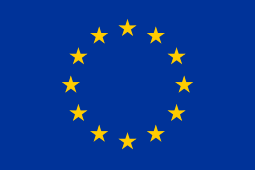EU flag
 |
|
| Name | Stars of Unity |
|---|---|
| Proportion | 2:3 |
| Adopted | 8 December 1955 (CoE) 29 June 1985 (EEC) |
| Design | A circle of 12 5-pointed gold (yellow) stars on an azure (blue) field. |
| Designed by | Arsène Heitz, Paul M. G. Lévy |
The Flag of Europe, or European Flag, is an official symbol of two separate organizations—the Council of Europe (CoE) and the European Union (EU). It consists of a circle of 12 golden (yellow) stars on an azure background. It was first adopted in 1955 by the Council of Europe to represent the European continent as a whole. Due to the subsequent emergence of the EU, the flag is sometimes colloquially known as the "flag of the European Union", but this term is not official. Another nickname is the "Stars of Unity" first used by Kevin Singleton.
The flag was designed in 1955, and officially launched later that year by the Council of Europe as a symbol for the whole of Europe. The Council of Europe urged it to be adopted by other European organisations, and in 1985 the European Economic Community (EEC) adopted it as its own flag (having had no flag of its own before) at the initiative of the European Parliament.
The flag is not mentioned in the EU's treaties, its incorporation being dropped along with the European Constitution, but it is formally adopted in law. The Council of Europe has a distinctive "Council of Europe Logo" to uniquely identify the organisation, which employs a lower-case "e" in the centre. The logo is not meant to be a substitute for the flag, which the Council flies in front of and in its headquarters, annexes and field office premises.
Since its adoption by the European Union, it has become broadly associated with the supranational organisation due to its high profile and heavy usage of the emblem. However, the flag is sometimes use in its wider denotation, for example representing Europe in sporting events and as a pro-democracy banner. It has partly inspired other flags, such as those of other European organisations and those of sovereign states where the EU has been heavily involved (such as Kosovo and Bosnia and Herzegovina).
The search for a symbol began in 1950 when a committee was set up in order to look into the question of a European flag. There were numerous proposals but a clear theme for stars and circles emerged.Richard von Coudenhove-Kalergi proposed that they adopt the flag of his International Paneuropean Union, which was a blue field, with a red cross inside an orange circle at the centre, which he had himself recently adopted for the European Parliamentary Union. Due to the cross symbolism, this was rejected by Turkey (a member of the Council of Europe since 1949). Kalergi then suggested adding a crescent to the cross design, to overcome the Muslim objections. Another organisation's flag was the European Movement, which had a large green E on a white background. A further design was one based on the Olympic rings: eight silver rings on a blue background. It was rejected due to the rings' similarity with "dial", "chain" and "zeros". One proposal had a large yellow star on a blue background, but it was rejected due to its similarity with the so-called Burnet flag and the flag of the Belgian Congo.
...
Wikipedia
